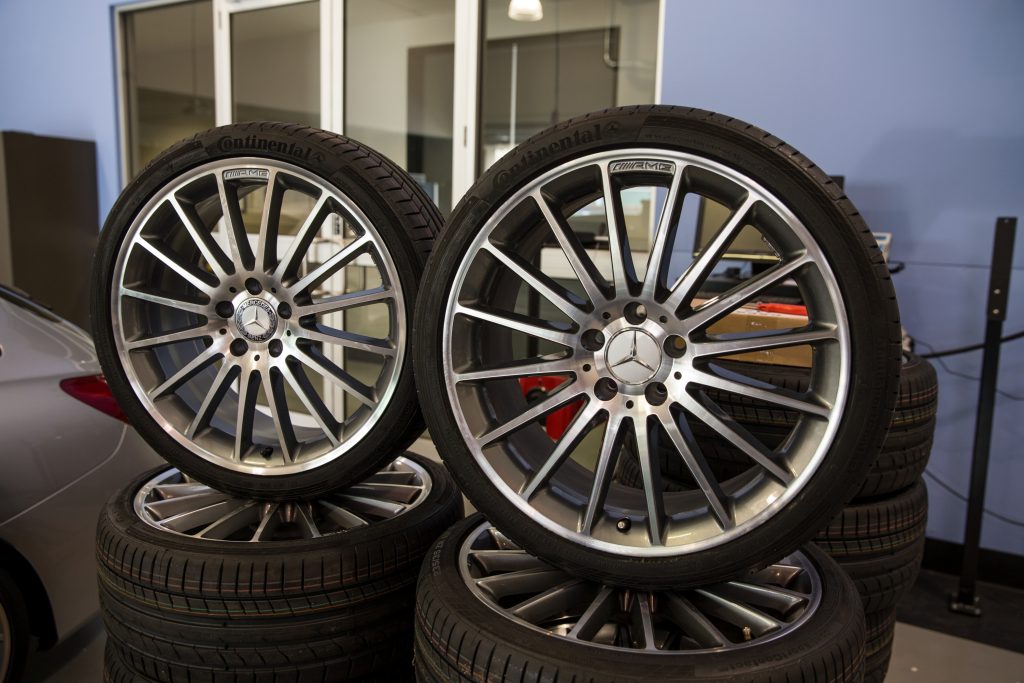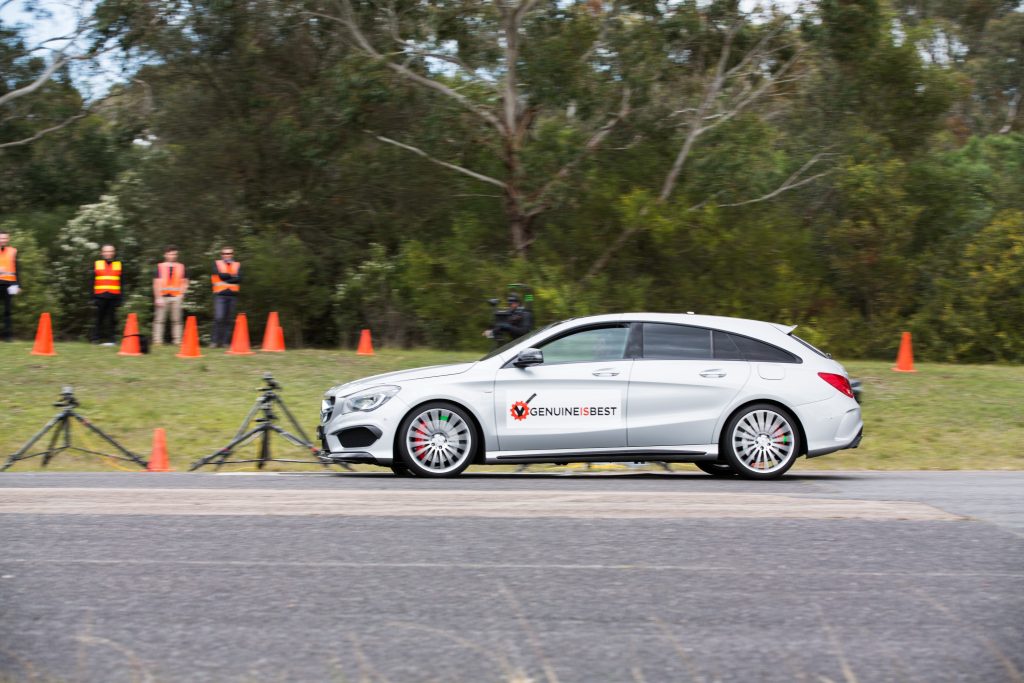A set of fake wheels on sale in Australia have been shown to dangerously disintegrate at just 50km/h in testing. The test was carried out by the Australian automotive industry and saw Mercedes-Benz Australia Pacific and GM Holden team up to demonstrate to consumers the serious safety risks that can be associated with fake parts.
Using imitation Mercedes-Benz wheels purchased online from an Australian-based seller, engineers set out to compare them to genuine wheels in an impact test.
The test was a pothole test, which saw fake wheels break apart at just 50km/h. This occurred in separate tests, one in which the point of impact was close to a spoke and one where the point of impact was midway between the spokes. Under the same tests, the genuine wheels sustained no visible damage.
“The genuine wheels performed safely under the same test and didn’t receive any visible damage while the fake wheels disintegrated at just 50km/h. This is the speed limit for residential areas in most parts of Australia,” Federal Chamber of Automotive Industries Chief Executive and Genuine Is Best spokesperson Tony Weber said.


“To make matters worse, when the fake wheels broke apart, sharp metal shards were flung off and landed many metres away, potentially putting passers-by at risk.”
Mercedes-Benz Australia Senior Engineer for Engineering, Certification and Testing Timothy Clarke said the low speed at which disintegration occurred was concerning.
“Travelling at 50km/h is a real-world speed and you can easily see people encountering this situation. A piece of rim breaking away is not only dangerous for the people in the car but also for those on the side of the road considering how far the piece flew. Based on those sorts of results I wouldn’t want to put those rims on my car,” Mr Clarke said.
Mr Weber said that it was horrifying to think what would happen if these wheels were on a family car that hit a pothole at highway speeds.
“You would have had an absolute tragedy if this breakage happened with a family on board at highway speeds. And the truth is these wheels could very well be on a family car on Australian roads — when we bought these wheels we discovered they were part of a larger shipment so there are more dangerous wheels exactly like this in the country, and possibly already on cars.


“And think about this, once they are on a car and then that car is sold second-hand, how would the new owner know or even suspect that these were dangerous fake wheels?”
Mr Weber said the decision was made to highlight wheels through this test because they are a common and easy part of a vehicle for car owners to change.
“Wheels are such a popular part for consumers to replace, whether it’s to make their car look sportier or to personalise it. But what people need to remember is that while different wheels change the look, they could also change the car’s safety performance,” Mr Weber said.
“And this is more than just about wheels — your car is built with genuine parts. Genuine parts are tested by the maker of your car for quality and safety. So when it comes to replacing any of them it’s vital to do so with a genuine part.


“Just recently we had the oil filter and airbag cable alerts — the Australian automotive industry is in a constant battle with counterfeiters and their potentially dangerous parts.
“We are urging Australians — please don’t risk it. It might be tempting to buy a set of cheap imitation wheels but don’t be conned — it’s not worth it. The way you can be totally sure you’re getting a genuine part is to buy it through the vehicle maker’s authorised supply chain.”
Mercedes-Benz service ensures your car will be fitted with genuine parts
THE AIM
The goal of this test was to compare the performance of genuine versus non-genuine rims in a controlled test environment simulating typical Australian road conditions.
THE METHOD
Wheels
The fake wheels chosen for the test were imitations of a Mercedes-AMG multispoke wheel seen on CLA 45 AMG, A45 AMG and C63 AMG models.
The fake wheel size was 19×8-inch with a 5x112mm stud pattern — the same as the genuine CLA 45 AMG wheel. While the fake wheel’s 43mm offset was 5mm less than that of the genuine CLA 45 AMG wheel, engineers from Mercedes-Benz and Holden agreed this difference would not affect test results.
Initial analysis of the wheels indicated that they were cast from a mould of a previous generation C63 AMG wheel, complete with Mercedes-Benz identification codes.
Weighing 12.77kg the fake wheels were 0.46kg heavier than the genuine C63 AMG wheel they were likely cast off and 0.35kg lighter than the genuine CLA 45 AMG multispoke wheel.
The fake wheels were found to be only slightly unbalanced.
Genuine and non-genuine wheels were fitted with a control tyre for the test. This was the same tyre Mercedes-Benz fits as standard to its Mercedes-AMG wheels — in this case a Continental ContisportContact in 235/35 ZR 19 size.
Purchasing
Four sets of the fake wheels were purchased through an Australian-based online store. The wheels were advertised for sale as new and suitable for a CLA 45 AMG.
Cars


Mercedes-Benz provided a CLA 45 AMG Shooting Brake vehicle for the test. The driver was the only occupant in the vehicle for each run of the test. Apart from the driver the vehicle was unladen. The vehicle was fitted with calibrated GPS measuring equipment to accurately determine and record the vehicle’s speed.
People involved
Overseeing the test was Holden’s Lang Lang Proving Ground Vehicle Safety Manager who was assisted by the proving ground and test lab’s engineering manager and a specialist engineer.
From Mercedes-Benz Australia there was a senior engineer for engineering, certification and testing and a technical support manager.
Behind the wheel of the vehicle was a Holden test driver.
Venue
General Motors Holden’s Proving Ground at Lang Lang was used for the test. The proving ground’s Pothole No.3 is a specially calibrated steel well with a gentle sloping entry and steep exit slope to replicate a pothole a driver could encounter in real-world Australian road conditions. In the test only the wheels on the right-hand side of the vehicle ran over the pothole.
THE RESULTS
The following table shows the damage to the front right wheel after each run though the pothole test. A new wheel was used for each run.
CONCLUSION
The pot hole test clearly demonstrated that the fake wheels were unable to match the stress tolerances of the genuine wheels at 50km/h.
At just 50km/h the fake wheels broke on impact while the genuine wheels remained visibly undamaged.
ENGINEER’S OBESERVATION
“It should be noted that the vehicle impact speed in the pothole testing was 50km/h and the vehicle was almost at its lowest possible mass. In many real-world driving situations the vehicle could be travelling at both a higher speed and loaded to a higher mass. In these higher energy scenarios the structural performance of the fake wheel would be expected to be even lower than that observed in our testing,” GM Holden Vehicle Safety Manager.
